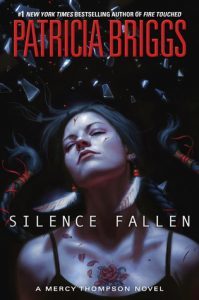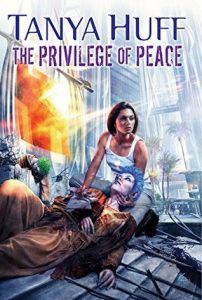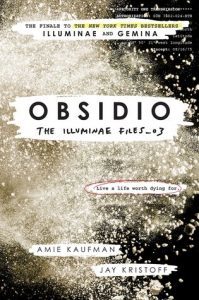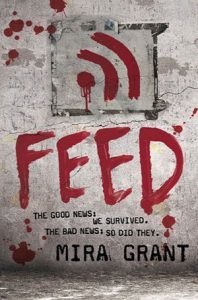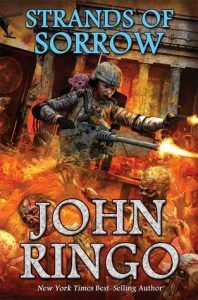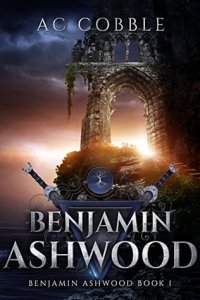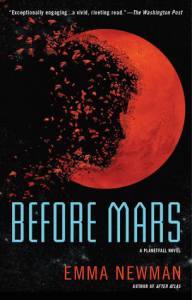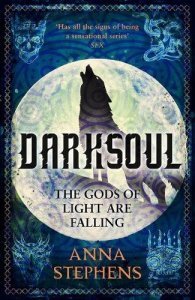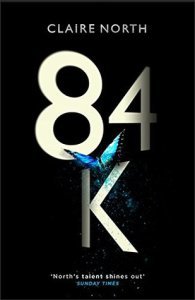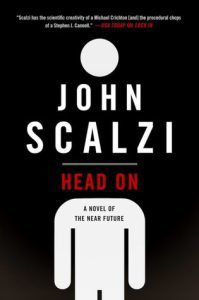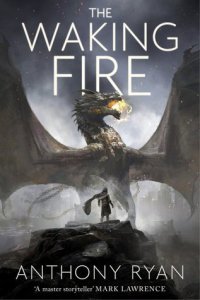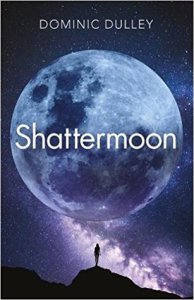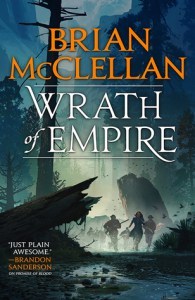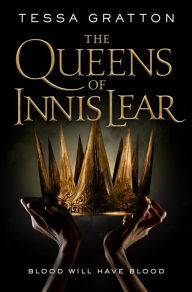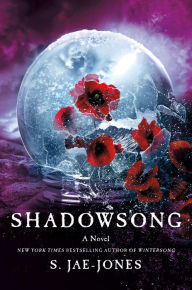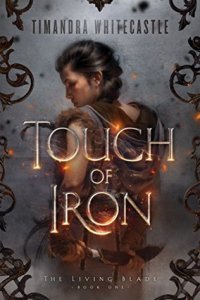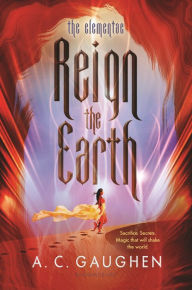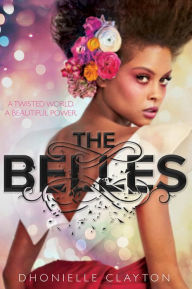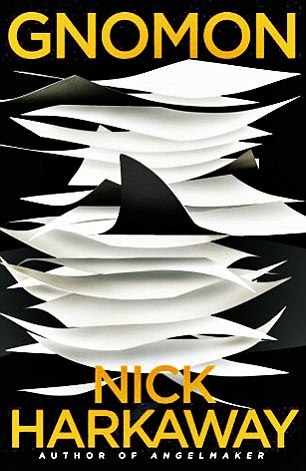Rachel Neumeier's Blog, page 242
January 25, 2018
Binge-worthy SFF series
From Omnivoracious, the Amazon book review blog, this: 6 Binge-worthy Science Fiction and Fantasy Series
This caught my eye because one of the series selected by the author of the post, Adrian Liang, is Wexler’s Shadow Campaigns series. I’m on the fourth book right now, and it is indeed a delightful series to read straight through. Long books though, not especially fast to read, so it’s kind of a project. Also, the first three books each wrapped up an important plot thread, so they can each certainly be satisfying read alone. I love them, but I would not say they stand out for inducing compulsive page turning; not nearly as much as plenty of other series; so as far as I’m concerned they don’t seem likely to induce compulsive binge-reading.
Of Liang’s other selections, I’ve read only the Vatta’s War series by Elizabeth Moon. I do like it, including the connected new series that’s ongoing (Vatta’s Peace), and I think that’s closer to a compulsive read.
My biggest problem with this series — both the first and now again in the second — is the intense stupidity of too many people. Things like, But how do we KNOW it’s bad guys who built this secret base and sabotaged our vehicle so we’d crash and also sabotaged every officer’s protective suit so you’d all die if you tried to wear them? I keep just looking at these people in stunned silence. It’s like, Well, gosh, if you all want to just sit here and assume these are nice people who will bring you hot cocoa in bed and apologize for inconveniencing you . . . I guess you could try that? Let me know how it works out.
It’s a bit as though there’s a stupidity-inducing mind-control laser directed at the whole galaxy, with only a handful of people immune. Not that the series isn’t fun! But if you read them all in a row, I bet you start rolling your eyes at the general stupidity, not to mention the strange, inexplicable hostility so many government officials seem to feel toward foreigners, and especially Ky Vatta.
Oh, looking again at Liang’s choices, I see she’s also included the Fallen Empire series by Lindsay Buroker. I did read the first book of that one, but as far as I’m concerned, it’s too similar to her fantasy Emperor’s Edge series to appeal to me. Same protagonists, basically; at least the male and female leads seem to be fundamentally interchangeable. On the other hand, the Emperor’s Edge series is pretty compulsive reading.
Well, anyway, moving on. This post made me instantly think of a handful of series that strike me as totally binge-worthy, in a compelling must-read-next-book-instantly-why-is-sleep-necessary kind of way. This is not the attitude epic fantasy series generally induce; epic stories are much easier to read slowly, without feeling deep deprivation if you must pause.
MUST HAVE THE NEXT BOOK NOW Series benefit from, I think, these characteristics: Fast-paced, quite a bit of action. Sharp, witty dialogue. Clever handling of tension, so that the reader is constantly wanting to read just the next little bit … and then the next after that … and so on.
I think series like this are more likely to come from UF, Paranormal, Postapocalyptic, and Military SF. That last category is a bit surprising to me, but when I think of the series I’ve found to be the most compulsive page-turners, Military SF series definitely tend to fall into that category. Big, sprawling epics, whether SF or fantasy, just don’t push the same buttons at all. At least not for me. Especially if they switch pov all the time; then I have to overcome the opposite tendency, a desire to stop when I reach the end of a favorite character’s pov section. For Wexler’s series, this means that any time the narrative switches from Winter to anyone else, I tend to stop for a while. This is true even though I like the other pov characters just fine.
Anyway, here are some of the series that most solidly hit my binge-reading buttons:
1) Ilona Andrews — Kate Daniels series. Magic Triumphs, the last book in the ten-book series (with associated other books and novellas), is due out this year.
The first two in the series are not as compelling as the rest. But this is very much a binge-worthy series once you get into it. Frankly the Hidden Legacy series strikes me as even more compulsively readable, but there are only three books in that series so far, so it hardly even counts as a series yet.
2) Patricia Briggs — Mercy Thompson. Well done UF is just more likely to be compulsive than epic fantasy, imo. There are ten of those as well. I really liked the latest, Silence Fallen.
3) Tanya Huff — Valor series (Confederation series; Peacekeeper series). Well-written military SF is just as likely to hit all the binge-this-now buttons as well-written UF or paranormals. As far as I’m concerned, Tanya Huff’s two linnked military SF series are the best of the subgenre.
4) Kaufmann and Kristoff — the Illuminae Files. EXTREMELY compulsive. Could be the most intensely compulsive books I’ve ever read — even though various aspects of the plot (every crisis but the kitchen sink getting clogged up, jammed into each book) make me roll my eyes even as I’m whipping through the books.
5) Myra Grant — Newsflesh trilogy. Talk about unbelievable plot elements! For Myra Grant, it’s (1) totally unbelievable giant conspiracies, and (2) eye-rollingly ridiculous magic cloning. . But for all my problems with the plotting, the books are totally compulsive.
6) John Ringo — Black Tide Rising. The four books of this series offered just a great reading experience, even though I am usually a character reader and I wouldn’t say characterization is their strength. Some types of books are just more compulsive page-turners than others, and I’d say military SF has a lot to offer if you’re looking for that type of series.
Please Feel Free to Share:









January 24, 2018
The Science Fiction and Fantasy Community Remembers Ursula K. Le Guin
At tor.com: The Science Fiction and Fantasy Community Remembers Ursula K. Le Guin
Please Feel Free to Share:









January 23, 2018
Worldbuilding: cities don’t all look the same, at all
Do you happen to remember the Laodd, the great fortress above the city in House of Shadows?
Well, this is the real-life fortress that inspired that one.
This is in Slovenia. I just happened to see a picture somewhere and I totally went head over heels for the whole idea of this fortress. Of course I blew it up in scale and gave it lots and lots of glass windows and poured a waterfall off the cliff next to the fortress, but this image was definitely the inspiration. I found it by googling “fortress in cliff,” I think.
In The White Road of the Moon, I specifically made the city of Riam colorful: “eggshell blue or soft green, madder pink or rich buttercup yellow . . . the colors glowed in the afternoon sun.” This description was inspired by this image of Cinque Terre, Italy:
Later, when Meridy and Jaift and everyone arrive in Cora Talen, they find that here the people “build narrow and tall, with umber-colored brick and slate.” I don’t remember for sure, but I might have been thinking of this image from Provence:
The City in the Lake and The Keeper of the Mist draw more on traditional images of pastoral Europe. Perhaps more like this:
My current WIP is set in a sort of SE Asian ecosystem, so that I’m drawing on that region for ideas about food and cooking styles, crops and wild plants, domestic animals and wild ones, weather and climate, clothing and materials, and definitely architecture. Of course there is an important magical element and naturally the society is quite distinctive, but I’m trying to make it decidedly non-European. Here are some of the images I’m working with as I build the solid underpinnings of the world:
These are images from Thailand, from China, from Bhutan, from Tibet. In the end I think my protagonists, and thus my readers, will get to see a good deal of their world. I look forward to showing it to them.
At some point maybe I’ll go back to a WIP I have sitting here that is set in a sort of alternate Turkey, where much of the landscape is similar to Cappadocia. That will let me draw on the beautiful architecture of the hot, dry, and even desert regions of the world:
One of the things to pay attention to when worldbuilding is the very different architectural traditions and styles that different societies have come up with, and how those fit into their surrounding ecosystems. If you, like me, are a visual writer, then images like these can become windows to the world you are building. Certainly the setting will inform both your characters and their quests.
There’s nothing wrong with medieval Europe as a setting for your story. But so many other beautiful settings are possible as well! Typing “beautiful traditional villages” or “beautiful ancient cities” into Google can be a great way to inspire yourself to reach outside traditional fantasy settings when you’re designing a world.
Please Feel Free to Share:









Bringing the past to life, with cooking
From Atlas Obscura, this: Putting ancient recipes on the plate
Each morning, Monaco picked her way across the site early, before it was beset by throngs of tourists. These walks, she says, stoked her imagination. She wondered about daily routines from 2,000 years ago, when the volcano was of little immediate concern and bakers and cooks fussed to fortify the busy city. What smells drifted from ovens in the morning? How did lunch taste? In pursuit of answers, Monaco decided to recreate a panis quadratus and bring the past into her kitchen.
This is just fascinating!
As you can imagine, trying to re-create ancient foods can present some significant challenges:
[A] general problem with reconstructing ancient cuisine is that specifics are hard to come by. For one thing, the written record is spotty. For many places and periods in the ancient world, Bottéro writes, “we can easily find out what they ate, but not how they prepared or enjoyed it.” … Even when ancient recipes have survived, their instructions can be maddeningly vague. The ingredients may evade easy translation or prove difficult to source. Among the oldest surviving recipes are three clay tablets housed in the Yale Peabody Museum of Natural History, from the Old Babylonian period, around 1700 B.C. Even translated from ancient Akkadian to English, they remain puzzling. The tablets’ age, fragile medium, and “long sleep underground” have erased some of the specifics, Bottéro writes. Other seemingly crucial fine points were omitted from the beginning. “There is still an element of interpretation, because [the tablets] don’t mention amounts, time, or other details that seem to have been taken for granted,” says Agnete Wisti Lassen, associate curator of the Yale Babylonian Collection.
One recipe, for a clear broth, reads like this, with brackets indicating illegible words and question marks denoting reasoned guesses: “Meat is used. Prepare water; add fat [ ], milk (?), cypress (?) as desired, and mashed leek and garlic. It is ready to serve.”
I guess our best modern approximation is those parish cookbooks, the ones that say “a can of crushed tomatoes” without specifying how big a can. Or your grandmother’s old recipes, recorded perhaps by someone who never used standardized measurements and that might assume you know how the dough should look and feel. Only even more vague than that!
To my considerable disappointment, there are no recipes offered at the link. However, I googled panis quadratus recipes and thus quickly found a take on the bread of Pompeii, here.
As you see, it is slashed into eight segments and has a deep horizontal indentation around the middle. Quite a handsome loaf.
The Baking Bread with the Romans post these ingredients in their recipe:
3.5 cups (600 gr) of Spelt Flour
3.5 cups (600 gr) of Whole Wheat Flour
3 cups (700 gr) tepid water
1 cup (200 gr) of leaven (starter)
2 tsp salt
Coarse ground flour or wheat bran for dusting
Spelt is an old variety of wheat. These days it’s not hard to find at health food stores, and I bet Amazon has it. I have some because it’s carried by Global Foods, which I visit a couple times of year.
I would expect a loaf that’s on the heavy, dense side, but there’s nothing wrong with that. The starter would contribute flavor. I’m not very used to working with starters, but it’s tempting to follow this Roman recipe and give it a try.
Please Feel Free to Share:









January 22, 2018
First Page Sins
From Jane Friedman’s blog, this: The Deadliest First Page Sin—Plus a Critique of Two Novel Openings
While there are seven deadly first-page sins I commonly encounter (which I detail at length in my book Your First Page), there is one that’s most deadly of all: default omniscience.
A story or a novel is as much about how it’s told—by means of what structure, through what voice or voices, from which viewpoint(s)—as about what happens. In fiction, means and ends are inseparable: method is substance. You may have all the ingredients—a plot, characters, dialogue, description, setting, conflict—but if they aren’t bound by a specific, consistent, and rigorously controlled viewpoint, you have nothing.
In workshops I’ve been known to write across the whiteboard:
NO POINT OF VIEW = NO STORY
I’m not talking minor gaffes and glitches. I mean errors so deep-rooted no line-editing can set them right, blunders that call into question not only the author’s grasp of a particular moment or scene in a story, but fiction’s primary purpose: to render experiences.
Fiction’s stock in trade is human experience, and experience is subjective: things don’t just happen; they happen insofar as characters feel and react to them.
Good point! There’s a lot more at the link, including this example:
Hank could have passed for Lila’s grandfather. His white mustache added to his years, yet he kept himself trim and thought himself as t as the younger fathers. He was nuts about Lila, who still loved him, though lately she’d grown distant. She was no longer his little girl; in fact, she secretly wished that he would act his age. She especially hated it when he pretended to pull coins and other things out of her ears. Why was he so goofy? But all adolescent girls pass through a phase where they hold their fathers in mild contempt.
At first glance, nothing seems wrong with this paragraph. But on closer inspection problems arise. While the first sentence (“Hank could have passed for Lila’s grandfather”) is neutral-objective, the second sentence (“thought himself…fit”) shifts us into Hank’s personal, subjective viewpoint. Though the third sentence seems to dip into Lila’s feelings about him, the thought expressed by it could still be from Hank’s viewpoint. However, unless we assume that Lila’s secret is not a secret, the fourth, fifth, and sixth sentences plunge us fully into Lila’s consciousness. With the final sentence we get yet another shift in perspective, to an omniscient, generalized view of all adolescent girls’ relationships with their fathers.
I have a mild disagreement here, because I think the paragraph does in fact feel all wrong from the very first glance. That point of view stuff is really pretty egregious.
It’s interesting to me that Friedman feels this is a very common problem with workshop entries. I’m not sure I’ve noticed it, at least not anything nearly as extreme as the above example. I would have said that failure to set the scene, sometimes going as far as a “white room” setting, is the single most common issue. But she has probably seen a lot more workshop entries than I have.
Interestingly, I would say that the first of the two 1st-page critiques offered at the link does not show failures with pov, but does in fact fail to set the scene. The second, which both Friedman and I like, does a vastly better job of setting the scene and placing the protagonist in it. Neither has a problem with pov.
So . . . pov. It’s probably true that unless viewpoint is effectively established, most reader can’t connect emotionally with the story. A couple of authors always spring to my mind when point of view comes up:
Clever use of omniscient or rapid switches from one viewpoint to another: no one does it better than Judith Riley in her Margaret of Ashbury series.
Amazing use of pov to avoid ever showing us the viewpoint of the actual protagonist: Dorothy Dunnett’s Lymond series.
Excellent use of a character’s specific and personal “voice” to draw the reader into the story: too many authors to mention, but The Hunger Games was a breakout sensation for a reason.
Extremely tight focus on one character’s viewpoint: CJC, for example with Bren Cameron and also with Cajeiri in Emergence, the latest Foreigner novel. Cherryh switches back and forth, with (for the first time, for me) Cajeiri’s viewpoint being way more fun. What a good idea it was to make him such an important pov character.
What are you all reading right now, and who is your favorite character?
Please Feel Free to Share:









Baking Special Treats for No Reason
Wow, was this past Sunday a big cooking day for me. I mean, among other things. I worked on my WIP in the morning, then made this interesting filled shortbread, then took some of the dogs to the park, then made khachapuri breads. There was no particular reason to make a lot of wonderful, interesting treats this weekend; it just worked out that way.
Both these recipes were good and impressive and rather easy, so let me share them with you in case you have a particular reason to want to bake specialty breads (or no actual reason, but you just want to).
So, first —
Lemon-Curd Filled Shortbread
This recipe is from this blog post, which I found because I googled “recipes using lemon curd.” Every so often my mother’s Meyer lemon tree ripens a fruit despite suffering from a terrible sunlight deficiency during the winter, and so I make Meyer lemon curd and then look around for stuff to do with it. Aside from just layering the lemon curd with whipped cream in little glass dishes, which by the way is hard to beat, but the following recipe only uses ½ C of lemon curd, so there was plenty for both uses.
I found the lemon actually rather subtle in this recipe, so I may try it again with raspberry jam, an alternative suggested by the original post. It was quite easy and the shortbread practically melts in your mouth, so it’s definitely worth making again.
Here’s what you need —
8 oz butter, softened
4 oz sugar
¼ tsp salt
10 oz cake flour (I used all-purpose)
½ C lemon curd
1 egg, for egg wash (I didn’t do this)
1 Tbsp sugar to sprinkle over top (or this)
Cream the butter, sugar, and salt. Add the flour. You can of course use cake flour, which will make the shortbread more tender and crumbly. I have to say, it was PLENTY tender and crumbly even using all-purpose flour, so my official position on this issue is: Do not make a special trip to the store for cake flour.
Whatever kind of flour you use, divide the dough into two portions. You can chill or freeze the dough at this point, but I went straight on.
Roll one portion of the dough out to a 12” round . . . mine was more like 10”. The original recipe says to roll it out and then transfer it to parchment paper and I was like, why would you make life hard for yourself? So I rolled it out actually ON the parchment paper. My widest baking sheet is just about 11”, so that’s how wide I rolled out the circle of dough. Yes, this is a very tender, soft dough. Just be gentle and use a tiny bit of extra flour on the top surface so the rolling pin doesn’t rip it up too much. It wasn’t that hard to roll out.
The way you keep the parchment paper from sliding all over the countertop while you roll out the dough, by the way, is to overlap the paper a bit over the edge of the counter and lean your body against the paper to pin it in place. It’s quite simple, a lot simpler, probably, than trying to transfer a delicate round of dough to parchment after you roll it out.
Move that round out of the way and roll out the second portion of dough to match, on a second piece of parchment paper.
Spread the lemon curd over one round of dough, leaving about ½ inch border. Use the parchment paper to lift the second round and invert it over the first. I realize this step has some potential for catastrophe, but in fact the dough stuck to the paper just well enough to make it pretty easy to line up the circles as I inverted the top one. The paper then cooperatively peeled off, so I definitely recommend this method.
Now, trim the edges to make a reasonably smooth circle – I was not obsessive about this – and crimp the border all around with a fork. Prick the top all over. Here’s where you could brush the round with a beaten egg and sprinkle it with sugar, but I forgot. I just dusted the whole thing with powdered sugar after it was out of the over and that worked fine as a finishing touch.
Bake at 350 degrees for 25 minutes or until lightly golden.
Incidentally, you can throw away the trimmed scraps of dough, but you can also make four or so thumbprint cookies and fill them with lemon curd. They got overbaked when I did this, so maybe put them on a separate sheet and bake for, I don’t know, 18 minutes maybe.
Cool before cutting into wedges and serving. Really tasty, especially if you don’t cool the shortbread quite all the way to room temp so that you get to eat a wedge while it’s still a little bit warm. I’m embarrassed to tell you how many pieces I ate in one day, but I will just mention I’m giving the rest to my mother, who loves shortbread and unlike me actually needs to gain weight.
So that was treat number one, and very pleasing it was!
Okay, later in the day I made these spinach khachapuri. After Christmas I always get myself a few cookbooks as for some reason everyone else seems to feel I have enough. Anyway, this year I picked up Samarkand, by Eden and Ford, and needed to use up some spinach, so I made these khachapuri boats. For the third time. They’re really good! I have never made them quite according to the recipe, but every variation I’m made has been great.
Spinach Khachapuri
1¼ C bread flour – I have been using a high-protein white whole wheat flour
1 tsp yeast
½ tsp salt
¼ tsp sugar – the recipe says superfine, but honestly, it’s just ¼ tsp, so what difference can it possibly make?
1/3 C plain yogurt – I used full-fat Greek yogurt, which I generally have on hand.
2 Tbsp warm water – I used at least 6 by the time I was done, possibly because Greek yogurt doesn’t have as much water in it as regular.
2½ C chopped spinach leaves. I have used fresh (which I zapped briefly in the microwave to cook just a little) and frozen (which I squeezed out) and I will say that I used too much spinach when I used frozen because I wasn’t sure how to much would equal 2½ C chopped fresh. Maybe more like 1 C frozen. Use your own judgment.
1 C grated mozzarella
½ C feta, crumbled
¼ C ricotta. I happen to dislike ricotta, so I used a pretty generous amount of cream cheese, which I like much better.
2 scallions, chopped
1 Tbsp minced parsley. I didn’t have any, so I left it out.
I Tbsp minced cilantro. Ditto.
1 tsp minced dill. I used dried.
3 eggs
Salt and pepper to taste
Make the bread dough. I used my stand mixer. Let rise two hours, it says. I let it rise a little less than one hour in a warm oven.
Combine the filling ingredients through the herbs. You can add one egg to the filling, but somehow I just never seem to. I think I didn’t have enough eggs the first time I made this and it worked fine without. Probably adding the egg would make the filling lighter and puffier. I should actually add it next time and see.
Divide the dough in half. Or thirds. Or fourths. I favor making these smaller, though the original recipe just makes two bigger khachapuri. I find even three a bit on the big side and will probably make four next time.
Roll each portion into a longish oval. Spoon over a matching portion of the filling and spread it out over the dough. Pinch the ends shut over the filling and make a boat shape, so your finished breads will look like this:
Preheat the oven to 475 degrees and put a pizza stone in the oven to get really hot. Slide the khachapuri onto the hot stone. Or use a plain baking sheet. Either way, bake for 10 minutes. Take out of the oven, push the filling aside in the middle of the boats, and break in an egg. Return to the oven for 5 minutes or until the egg is just set.
Now, I have had trouble getting the eggs to set. I don’t mind a liquidy yolk, but a liquidy white – ugh. So twice I have put the khachapuri under the broiler for a minute to finish the eggs. This time I just let them bake a little longer. Either way, the bread gets really brown, so what I actually suggest is, bake for just 6-7 minutes first, then break the eggs into the middle, then bake another 7 minutes or so, until the eggs are set to your taste.
Cool enough so you won’t burn your mouth and there you go. The original recipe says “Serve with a slice of cool butter on top” which you can certainly try if that appeals to you, but it seems completely unnecessary to me. Definitely an excellent brunch idea if you’re having company.
Please Feel Free to Share:









January 19, 2018
Everything has gotten so dark…
… Cover art, at least.
Check out these covers, all pulled off various Most Anticipated SFF of 2018 lists:
I am not familiar with these books, by the way. I just happened to glance at some Most Anticipated lists and this really strong tendency toward DARKNESS leaped out at me. Now that I posed a bunch of covers in a row, I’m seeing there is also a GIANT FULL MOON theme, though not as consistently as just DARK DARK DARK. This is by no means a complete set of all the dark covers I saw; I just got tired of copying them.
It’s not that I think these are bad covers. Anything cartoonish or too stylized usually turns me off, so I am not attracted at all to that Scalzi cover. The super-simple Clair North cover does sort of grab me. The cover with the dragon, well, I am pretty much willing to look at covers that feature dragons. I like that Touch of Iron cover. The Giant Full Moon trope appeals to me, apparently — I like every cover up there with a full moon.
But mostly I find myself longing for a splash of color and light. I think these, also off Most Anticipated lists, are going to stand out from the crowd this year:
Please Feel Free to Share:









Not really an award
Here’s something kind of fun:
Announcing the 2018 Subjective Chaos Kind of Awards!
Well, actually… it’s just a bit of fun that a group of scifi and fantasy readers, including me, have decided to indulge into by looking at the 2017 published scifi and fantasy stories and trying to pick up our favourite.
From a blog called The Middle Shelf, these … not really awards. I like the lack of seriousness, actually. Beth of Bethan May Books says, “Not really an award. There is no prize. Or a ceremony. I will be drinking though.”
I like the categories:
– Best scifi novel;
– Best fantasy novel;
– Best story that blurs the boundaries;
– Best novella (either scifi or fantasy);
– Best series (either scifi or fantasy).
I like that “blurring the boundaries” category. Here’s the shortlist for that category:
A. Caldecott, Rotherweird.
N. Drayden, The Prey of Gods.
R. Emrys, The Winter Tide.
N. Harkaway, Gnomon.
F. Lee, Jade City.
M. M. Smith, Hannah Green and her Unfeasibly Mundane Existence.
J. Williams, The Ninth Rain.
I am curious to see what each of those books looks like and why it has been included in this category. I will say, I have only tried one of these (The Prey of Gods) and I did not get very far in it. It had too gritty a tone for me. I think it is SF? But maybe it intergrades somehow with fantasy or horror or something, and that is why it’s in this category?
I’ve seen plenty of references to Jade City, but I haven’t looked at it yet.
I think Hannah Green and her Unfeasibly Mundane Existence is a fun title.
Gnomon has the most intriguing cover.
I’m going to try to remember to follow along a bit and see how this “non-award” develops.
Please Feel Free to Share:









Jupiter, the planet painted by Van Gogh
Have you seen these awesome photos of Jupiter?
Like this one:
I look at these pictures and I have to wonder, was Van Gogh having visions of Jupiter or what?
Lots more beautiful pictures of Jupiter at the link!
Please Feel Free to Share:









January 18, 2018
Who needs writing skill? There’s an app for that.
At Quartz, this: Don’t like the way you write? An artificial intelligence app promises to polish your prose
Which is an annoying use of the term “artificial intelligence,” to start with, and sounds pretty iffy in general. Polish your prose, eh? Let’s just see how this is supposed to work:
The Hemingway App … promises to do just that. “Hemingway makes your writing bold and clear,” the site claims, so that “your reader will focus on your message, not your prose.” If you listen to the app’s advice, it will rid your writing of run-on sentences, needless adverbs, passive voice, and opaque words. There’s no guarantee you’ll crank out the next Farewell to Arms — but the goal is to get you closer to Ernest Hemingway’s clear, minimalist style.
Ah! It will rid your writing of the passive voice! How useful! That way instead of writing something like, “Worst morning ever! My poor dog was hit by a car! She ran away crying and limping and it took me four hours to catch her. Thank God she was all right.”
Now you can write: “I had the worst morning ever! Someone hit my dog with their car! I mean, his or her car. Anyway, my poor dog ran away …”
And for all I know, the Hemingway app would also be offended by your exclamation points.
I see it costs $20 to get the app, and I don’t see a way to try it out for free, so the above sentences are just guesses about what the app might do. This is just an example of passive voice that shows how perfectly appropriate it can be when you actually do want to emphasize the object rather than the subject. Who cares about the car or the driver? The dog is obviously the important thing in the sentence. Passive voice allows that to be expressed.
Anyway, it turns out this app is not brand new. Here is an article from The New Yorker, written in 2014: Hemingway Takes the Hemingway Test
Take this description of Romero, the bullfighter, in “The Sun Also Rises”:
Afterward, all that was faked turned bad and gave an unpleasant feeling. Romero’s bull-fighting gave real emotion, because he kept the absolute purity of line in his movements and always quietly and calmly let the horns pass him close each time.
This breaks several of the Hemingway rules. The passive voice loses points, as do the two adverbs at the end. But “quietly” and “calmly,” are, of course, essential to the point. Bullfighters, masterly or not, avoid the horns most of the time. Only the artists like Romero manage it quietly and calmly. And that word, “quietly,” which is not quite literal, is a little surprise. Regarding the passive voice, it injects emotional uncertainty into the scene. “All that was faked turned bad,” scans like a melody, and in its passivity and slightly odd tense, feels like an elegy. It is not exactly clear. But it’s bold.
Amusing example! Also, an apt observation: I think we can assume that any app that zealously applies rigorous rules is going to produce text that lacks poetry.
Please Feel Free to Share:











